Latinx History Tour Companion#
Disclaimer: The information about sites below relies on primary source material from Fort Collins history that often used racist and offensive terms to refer to Latinx Americans residing in the city. In some cases, those terms have been included here to acknowledge and accurately reflect on the experiences of Latinx Americans in Fort Collins and the challenges they faced, and sometimes still face, while living here.
Download the Brochure
This is an online companion to the walking tour brochure for Latinx history in Fort Collins.
Latinx history is endemic to the Fort Collins experience and is woven throughout multiple neighborhoods within the city. As a result, this tour is broken up into four parts reflecting four key areas of importance for Latinx residents of Fort Collins from the 1900s through the 1990s.
We encourage you to explore these sites on your own time, by car, bike, or on foot. Please share the street and be respectful to the privacy of the owners and residents of the homes on this tour by viewing them from the street/sidewalk only.
Tres Colonias, Great Western Sugar, & Downtown Fort Collins#
Some of the earliest places where Hispanic residents in Fort Collins began living by the early 1900s were in the vicinity of the Great Western Sugar factory on East Vine Drive northeast of downtown Fort Collins. Alta Vista, developed as “the Spanish Colony,” was purpose-built by Great Western Sugar to recruit Mexican American and Mexican national families to Fort Collins to work on local beet farms or in the factory itself. Over the 1910s and 1920s, Buckingham and Andersonville became predominantly Hispanic along with the north end of downtown near the Poudre River.
1 - Alt Vista, the "Spanish Colony"#
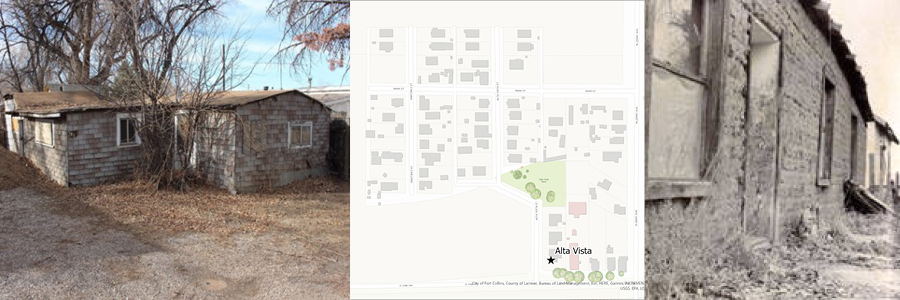
Left: 741 Lindenmeier (Lemay) Road, at the northeast corner of Alta Vista, 2017; Right: An adobe structure in Alta Vista, no date (H08086, Courtesy of the Fort Collins Museum of Discovery).
While Alta Vista was the third of the three sugar factory neighborhoods to be built near the Great Western Sugar plant, it was the first that exclusively catered to Mexican American families that had been recruited by the company. Built in 1923, largely using Spanish-styled adobe dwellings, the neighborhood housed factory and farm workers involved in the sugarbeet industry. Most were immigrants from Mexico recruited by Great Western Sugar seeking the economic opportunity and leaving a Mexico still reeling from its revolution in the 1910s. Like all of the Tres Colonias, Alta Vista residents suffered from the lack of public infrastructure like water and sewer in the neighborhood until the 1970s. Today, the neighborhood retains several of the original adobe structures, although they have been re-sided in some cases, and includes other frame houses built during the 1920s. The conditions of homes varies significantly. An historic property survey in 2003, revisited in 2017, made recommendations for preserving the important history of Alta Vista and highlighted properties like the Charlie Martinez House at 736 Martinez Street and the Griego House at 741 Lindenmeier as important reflections of the neighborhoods Hispanic heritage and unique building techniques. Since that time, no properties in Alta Vista have been designated or protected as historic. The Griego House was demolished in 2022.
2 - Andersonville#
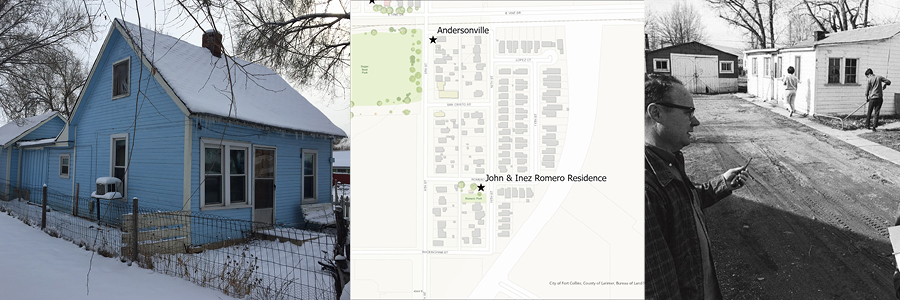
Left: 520 9th Street (Lemay) in Andersonville, 2015; Right: Rev. Robert Gellar supervising a community center project at 419 10th Street, 1967 (C01177, Courtesy of the Fort Collins Museum of Discovery).
Andersonville was initially built up by the Great Western Sugar Company after 1904 as a predominantly Volga German neighborhood, comprised of Germans from Russia recruited by the company to work in the sugar beet industry. As ethnic Germans made economic gains and adapted to life in Fort Collins, they were usually able to assimilate and join other white residents in neighborhoods south of the Poudre River. In the 1910s-1920s, Andersonville shifted to a predominantly Hispanic community as Great Western Sugar recruited families from Mexico to fill the labor gap left by the Germans, and as a means to secure year-round labor for the sugar beet industry. The small neighborhood became home to families who became prominent in Fort Collins’ Mexican American community, including John and Inez Romero who lived at the adobe house at 425 10th Street. An historic property survey in 2003 made some recommendations to preserve the heritage of the neighborhood, centered on preserving the Romero House, Landmarked by the City in 2001.
3 - John & Inez Romero Residence, 425 10th Street#
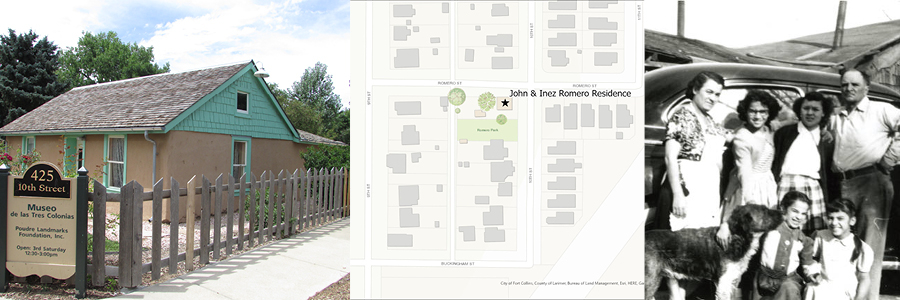
Left: Romero House & Museo de las Tres Colonias, 2014; Right: Romero family in c.1953, (H19733, Courtesy of the Fort Collins Museum of Discovery).
The small adobe home in front of you was the home of influential Tres Colonias residents John and Inez Romero. John was born in Santa Fe in 1897 and moved to Fort Collins in 1920 to work for the Colorado & Southern Railroad. Inez Rivera’s family moved to Fort Collins in 1916 when she was eight years old. Inez’s father Frederico worked in the beet fields while her mother, Antonia, served the Hispanic community as a curandera, a practitioner of herbal folk medicine. Inez married John Romero in 1925 and they built this adobe house in 1927, eventually raising a family of seven children. John became a notary public to support other Mexican American families with legal papers. He also acted as an interpreter and the two supported children’s welfare fundraising in the community. They remained in the home for the remainder of their lives until John passed away in 1975 and Inez in 2000. Romero Street and Romero Park are named in their honor. Today it is the Museo de las Tres Colonias, dedicated to remembering the history of the Romeros and Tres Colonias.
4 - Great Western Sugar Factory, Vine Drive#
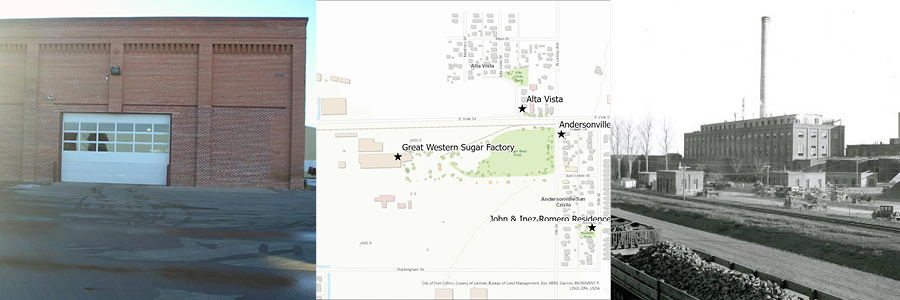
Left: One of the warehouses at the Great Western Sugar plant now used by the City's Streets Division; Right: The Great Western Sugar Factory in 1932, looking southeast from Vine Drive (H10175, Courtesy of the Fort Collins Museum of Discovery).
While agriculture in Fort Collins had, and remained, more diverse than the sugar beet industry since the town’s foundation, sugar beet growing and processing led to the swift expansion of Fort Collins between 1900 and 1930. As farmers grew sugar beets to provide a domestic source of sugar in the United States, the Fort Collins Sugar Manufacturing Company built the factory in 1903, the remnants of which remain on East Vine Drive. Just two years later, Great Western Sugar, the single largest producer of beet sugar in the United States, acquired the plant and kept it in operation until 1960. During its operation, the factory, and the farms that supplied it in northern Colorado, were one of the key draws for Hispanic, mostly Mexican American, families to relocate to Fort Collins from southern Colorado, New Mexico, and northern Mexico. Jobs in the factory, or jobs on sugar beet farms, provided economic opportunity, although they also relied on the same exploitative labor practices first imposed on the Germans from Russia. Both for the work it offered, and the hazards, poor wages, and environmental degradation it caused, the factory remained at the center of Latinx life for the first half of the twentieth century. Today, several of the larger buildings and the smokestack have been demolished, but the remaining buildings have been repurposed as the City of Fort Collins’ Streets Division headquarters.
5 - Buckingham#
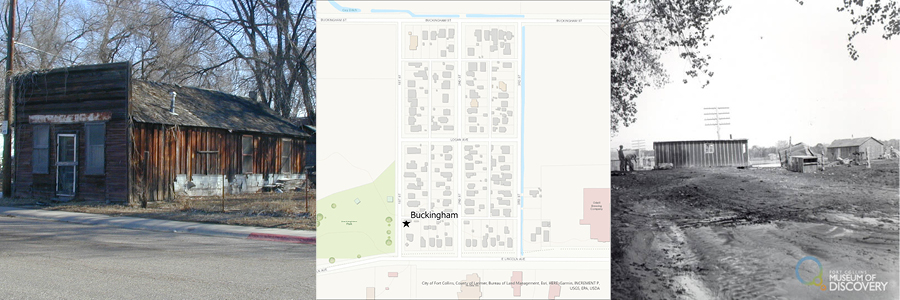
Left: The store at 100 E. 1st Street, one of two known to have operated in Tres Colonias during the period when Latinx residents were barred from most businesses in downtown Fort Collins; Right: Buckingham following a severe flood in 1904 - the neighborhood was prone to flooding (H02438, Courtesy of the Fort Collins Museum of Discovery).
Like Andersonville, Buckingham was developed in the 1900s as a sugar factory neighborhood, initially housing ethnic Germans from Russia recruited by Great Western Sugar. The area suffered a severe flood in 1904 (pictured above) that wiped away many of the homes in the neighborhood. Beginning in the 1910s, many Germans began moving out of the neighborhood to better maintained areas of Fort Collins on the south side of the Poudre River, and new families living here were mostly from Mexico, also recruited by Great Western Sugar. From about 1920 into the 1980s, the neighborhood remained predominantly Mexican American. Some properties of special interest are the Santiago Alarid House & Store at 100 E. 1st/Lincoln Avenue and the Steely Barreras House at 224 2nd Street, and included the Deines Torgerson House at 209 Third Street that was, unfortunately, demolished in 2015. The Store at 100 E. 1st Street was first established when this was a neighborhood for Germans from Russia who were also frequently denied service in downtown establishments. With the context of discrimination carrying over to Hispanic residents by the 1920s, the store continued to serve as local place for goods owned by and serving Tres Colonias residents.
6 - El Burrito & North Downtown#
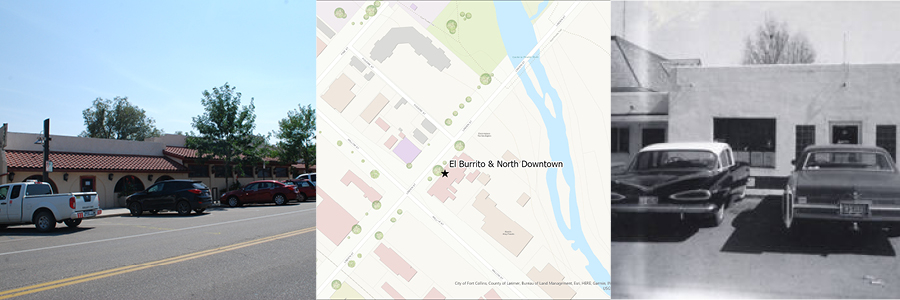
Left: El Burrito & 400 Block of Linden Street - the Godinez family eventually acquired most of the block on both sides, as well as other properties in downtown Fort Collins; Right: El Burrito in 1979, about twenty years after the Godinez family established the restaurant (404Lin79, Courtesy of Fort Collins Museum of Discovery).
The north end of downtown has also been a long-standing Mexican American neighborhood, although many of its physical reflections are gone. One of the icons of that neighborhood remains in El Burrito, established by Jesse and Dorothy Godinez in 1960 and one of the longest-running restaurants in Fort Collins. The Godinez family owned a significant amount of real estate along Linden Street during the 1940s and 1960s, and made El Burrito one of their main personal operations. However, the surrounding blocks used to be a small enclave of working class cottages that were built over the late-1800s and early 1900s, and by the 1930s, were predominantly occupied by Mexican American families. The Godinez’s lived at 405 Linden Street, just across from their restaurant. Other notable families lived nearby as well, including the Vallecillo family at 402 Pine Street – Jovita Vallecillo Lobato was the first Mexican American graduate of both Fort Collins High School and the Colorado Agricultural College (now Colorado State University). The Vallecillo residence has since been demolished.
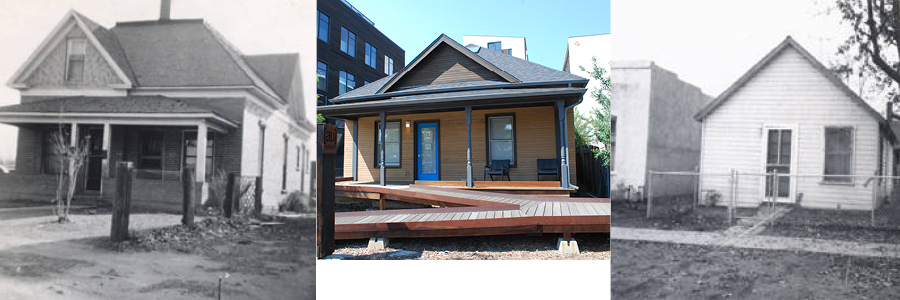
Left: 410 Linden St, 1948, immediately north of El Burrito, eventually owned by the Godinez family (410Lin48, Courtesy of the Fort Collins Museum of Discovery); Center: 405 Linden Street, the former Godinez residence while they were operating El Burrito; Right: 402 Pine Street, the former Vallecito Residence, torn down prior to 1974 (402Pin69, Courtesy of the Fort Collins Museum of Discovery).
7 - Joe's [Cienfuegos] Auto Upholstery, 247 Linden St#
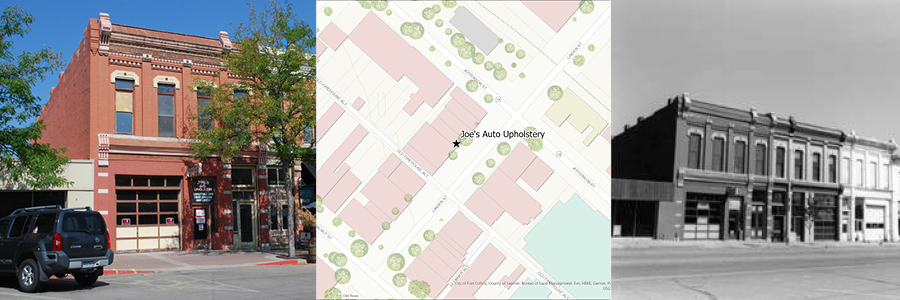
Left: 247 Linden Street, Joe's Auto Upholstery; Right: 247 Linden in 1983, when Joe's was still in business (H09706, Courtesy of the Fort Collins Museum of Discovery).
Joe Cienfuegos, Sr., was among one of the most long-standing Mexican American businesses owners in Fort Collins. He was born in 1920 in Chihuahua, Mexico to Socorro and Refugio Cienfuegos, who moved to Fort Collins shortly thereafter to work at the Great Western Sugar factory. Joe eventually worked for Johnny Ahers, a local mechanic, and married Teresa Dominguez in 1940. He enlisted in the Army in 1942 and served in Europe with the 3rd Division, 7th Army, rising to the rank of sergeant. Cienfuegos was wounded and imprisoned in a German POW camp. After his release, Joe returned home, was granted citizenship, and purchased 247 Linden Street where he opened up an auto upholstery shop. Despite being a wounded veteran, Cienfuegos, like many other Mexican American residents of Fort Collins, faced regular discrimination in the years following his return home, including being refused service at several downtown establishments. His business remained family owned after his death in 2011. The family recently sold the Linden Street building to new owners and moved the business two blocks north to 310 Willow Street.
The Legacy Continues
In 2021 as part of Latinx/Hispanic Heritage Month, the City's Economic Sustainability team interviewed Richard Cienfuegos, Joe's son, about his father and the continuing legacy of Joe's Auto Upholstery, now located at 310 Willow Street.
The Holy Family Neighborhood#
As the Mexican American community expanded in the 1920s with the growth of the sugar beet industry, many residents began moving into the northwest corner of Fort Collins, including areas of the original 1873 plat, the West Side Addition, and the Capitol Hill Addition. The neighborhoods being built there by the 1900s provided better quality housing, and proximity to more goods and services in downtown, although Mexican Americans faced widespread discrimination in many Fort Collins businesses. The Holy Family Catholic Church at Whitcomb and Cherry Streets served as a religious, cultural, and social anchor for the entire Hispanic community, including the residents of Tres Colonias. Many of the Latinx community’s leading political, social, and business figures made their homes in the blocks immediately surrounding the church between downtown, the Poudre River, Shields Street, and Laporte Avenue.
8 - Holy Family Catholic Church & Parish Hall#
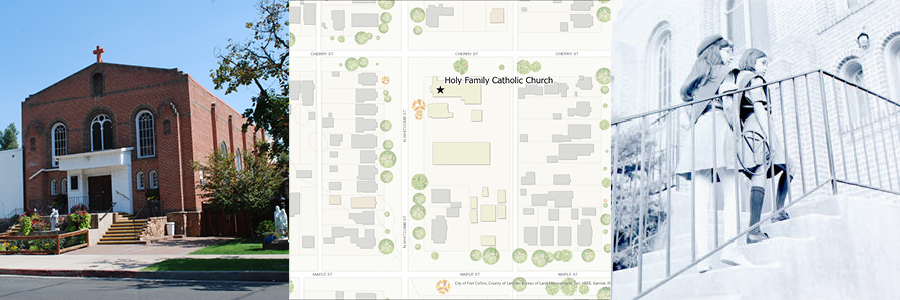
Left: Holy Family Catholic Church at 326 N. Whitcomb Street; Right: Girl Scouts at Holy Family, 1968 (H20855, Courtesy of the Fort Collins Museum of Discovery).
The Holy Family Catholic Church and Parish Hall was, in many ways, the beating heart of Fort Collins’ Mexican American community. Initially, Mexican Americans worshiped alongside their Anglo neighbors at St. Joseph’s Catholic Church at Mountain & Howes, although sometimes the church offered Spanish language services to those who needed them. However, the growing Spanish-speaking population and racist attitudes on the part of many Anglo parishioners led to the establishment of a separate Mexican American congregation in the mid-1920s. By 1925, the congregation established a “Mexican Catholic Church” at 600 Cherry Street, the former Westside or Second Presbyterian Church. However, that building eventually proved too small for a congregation growing into the several hundreds. In 1929, the congregation built a larger, brick church that stands on the southeast corner of Cherry and Whitcomb Streets that remains today.
Since 1929, Holy Family Church has been the social anchor for many Mexican American families in the city. Church officials like Father Juan Fullana (1937-1950) advocated for better working conditions, access to education, and social programs, often providing them from the church itself. After the City condemned the former church at 600 Cherry Street that was being used as a Mexican American school, Father Fullana offered the Parish Hall as a school facility, which served that purpose until 1969. Families and local leaders organized many events here, from community-wide commemorations of Cinco de Mayo and el Dia de los Muertos to family birthday celebrations and quinceañeras. It remains one of the most prominent social institutions in the Latinx community today.
9 - Lee Martinez Residence, 728 Sycamore Street#
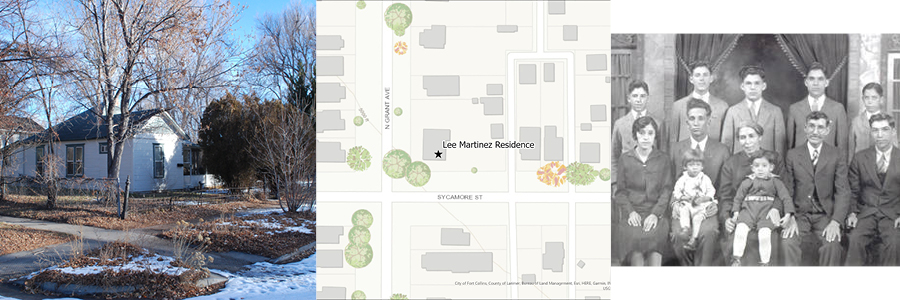
Left: Martinez Residence at 728 Sycamore Street; Right: The Martinez Family in 1929, with Librado "Lee" in middle row, second from left (H13463, Courtesy of the Fort Collins Museum of Discovery).
The Martinez family, led by Librado “Lee” Martinez, is one of the most prominent Mexican American families in Fort Collins history. Lee was born in Huerfano County, Colorado in 1889, and adopted and raised by Nestor and Santana Martinez. They moved to Fort Collins in 1906 where Lee spent much of the rest of his life. The family worked in the sugar beet fields and lived in various areas near Fort Collins including Buckingham through the 1920s. Lee also served in the Army during the First World War. Lee eventually met his wife Eva Martinez, and the two married in 1924. They moved around Weld County early in their marriage, including farming in LaSalle and Kersey. They returned to Fort Collins in the 1930s and lived at several addresses around the city including 728 Maple Street and 512 N. Grant Avenue before they settled, in 1942, into a more permanent residence at 728 Sycamore Street that remains today.
Lee and Eva remained connected with the larger Holy Family community and shared what they could with their neighbors. Like many Mexican American families, military service was common – their son Alonzo served in Europe during the Second World War and was killed in action near Beffe, Belgium in January of 1945. They were also politically active. Lee was a strong supporter and organizer for the local Democratic Party, due to the party’s effort to combat the widespread discrimination against Mexican American and Black families in Colorado, and Fort Collins, at the time. Lee co-founded the Alonzo Martinez American Legion Post 187 which was for Latinx veterans denied membership to the existing George Beach Legion post at the time. Lee died in April of 1970. Eva passed away in 1997 and the home remains in their family today. In 1975, as the City of Fort Collins worked to establish a new park north of the city along the Poudre River, it was named after Lee Martinez in honor of his work to benefit the community.
10 - Lee Suniga Residence, 818 & 818 1/2 Sycamore Street#
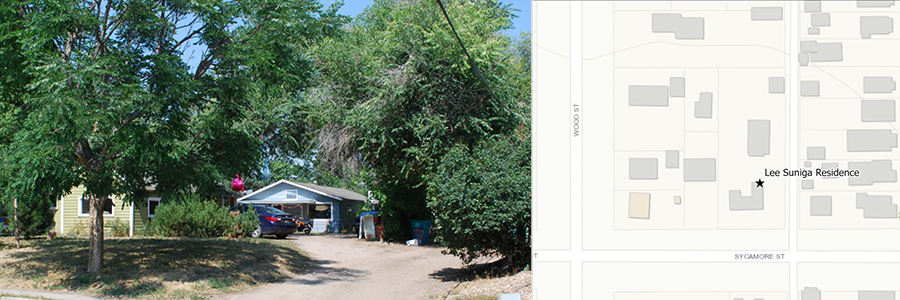
Suniga Residence at 818 and 818 1/2 Sycamore Street during most of Lee Suniga's baseball career.
Lee Suniga was another important advocate for Latinx residents in Fort Collins. Born in Colorado around 1923, Suniga’s family were farm laborers in the Harmony community near Ziegler and Kechter Roads, but moved to 818 Sycamore Street in 1940 and appears to have lived there through 1970. Lee worked as a sugar beet laborer from his teenage years, but eventually became a local leader through the development of baseball teams in the city. There were several primarily Mexican American baseball teams playing in Fort Collins including the Legionaries, Merchants, and Rebels. For their early years in the 1920s through the 1950s, these teams were largely segregated, but they served to help break down racial barriers as more Anglo residents in Fort Collins attended the games and began to also play on the teams. Lee played for the Legionaries and later on helped manage the teams and was instrumental in establishing the Colorado Hispanic Baseball Hall of Fame. Suniga Road is named after him and his contributions to Fort Collins history.
11 - Joe & Teresa Cienfuegos Residence, 326 Wood St#
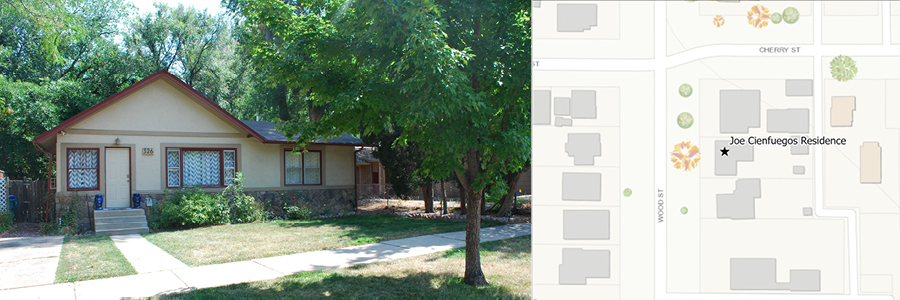
Joe & Teresa Cienfuegos Residence during most of the time when Joe was operating his upholstery shop on Linden Street. In the early years, Joe lived above the shop.
Joe Cienfuegos was born in Chihuahua, Mexico in about 1920 but his family moved to Fort Collins like so many others to work in the sugar beet industry. By 1940, Joe, or Jose in official records, was working as an auto mechanic and living upstairs at 253 Linden Street. When the Second World War broke out, Joe served in the Army. Upon his return, he had saved enough money to open his own auto upholstery shop on Linden Street, one building down from his pre-war residence. He was also able to purchase a home at 516 N. Grant Avenue by 1948 for him and his wife Teresa, which remains today. By 1952, they had moved to 326 Wood Street.
12 - Fullana Elementary School, 220 N. Grant Avenue#
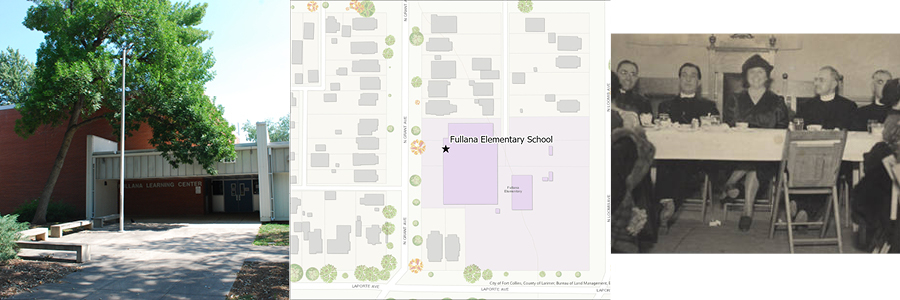
Left: Fullana Learning Center, formerly the Fullana Elementary School; Right: A banquet in 1937, showing Father Juan Fullana at far right (H22797, Courtesy of the Fort Collins Museum of Discovery).
The Fullana Elementary School (Fullana Learning Center) is named after Father Juan Fullana, the priest for Holy Family Catholic Church from 1937-1950. Fullana was a staunch advocate for equal access to education for Mexican American students and even opened the Church’s Parish Hall for use as a school in 1948. The Parish Hall school operated until 1969 when funding ran out. Latinx residents ran a successful bond campaign in 1969 for the school district to fund construction of a new elementary school on Laporte Avenue and the former site of the Laporte Avenue School. However, the school district sought to reappropriate the funding for a new, mostly white, neighborhood just south of town. With the legal representation of Frederico Peña, future mayor of Denver, the neighborhood forced the school district to spend the funds as originally intended, and the district built Fullana Elementary here in 1975. Today it is a multi-purpose learning center for various age groups and family backgrounds in Poudre School District.
13 - City Hall & Fort Collins Police Offices, 300 Laporte Avenue#
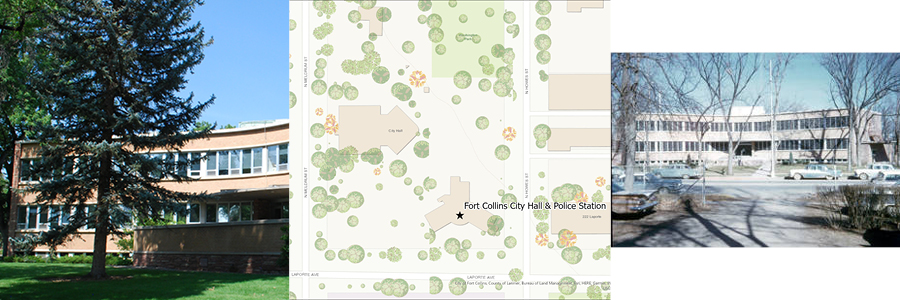
Left: The former City Hall & Police Department headquarters at 300 Laporte Avenue (1957-1977), prior to the current City Hall being built in 1977 immediately to the west; Right: The City Hall building in 1959 shortly after completion (S00270, Courtesy of the Fort Collins Museum of Discovery).
As the Chicano Rights movement gained momentum in the 1950s and 1960s, leaders across the country organized for a variety of purposes, from community building, to labor organization and combatting discrimination in the courts, to protesting the harassment of Latinx residents by local police. In Fort Collins, Chicano leaders regularly picketed the City Hall & Police Station at 300 Laporte Avenue from the 1970s through the 1990s in response to ongoing harassment by the police. Members of the United Farm Workers (UFW) as well as student organizations like UMAS (United Mexican American Students) and MACE (Mexican American Committee for Equality) organized protests for a variety of reasons to empower Latinx residents in Fort Collins. Other protests included a 1969 student protest at CSU President Morgan’s residence on Shields Street (see below) and a boycott in front of the city’s Safeway groceries in 1972 in support of national lettuce pickers who were members of UFW.
North College Avenue#
After the Second World War, as the Latinx community expanded further and gentrification began displacing Latinx residents from Tres Colonias and the Holy Family neighborhood, new neighborhoods and businesses grew on North College Avenue.
14 - Pobre Pancho's, 1802 N. College Avenue#
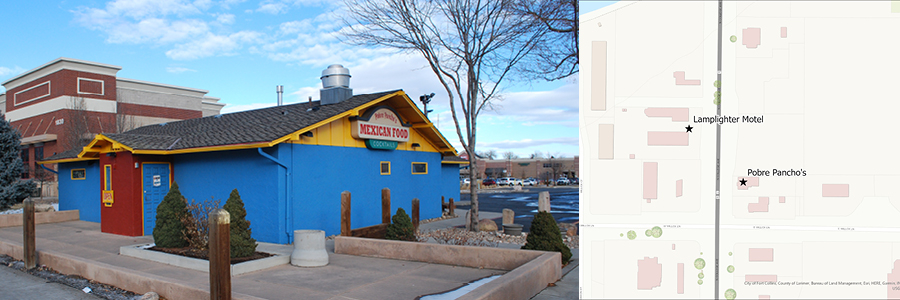
Pobre Pancho's at 1802 N College Avenue.
Pobre Panchos was founded in 1967 by Frank Perez originally in downtown Fort Collins on Walnut Street. By 1969, Frank and his wife Mary moved the restaurant to its current location on North College Avenue. The establishment of the second restaurant was a sign of the growing number of Latinx residents living along North College Avenue, typically in seasonal worker’s shacks or in the mobile home parks that began developing north of the Poudre River as a result of gentrification and displacement from neighborhoods like Holy Family and Tres Colonias.
15 - Lamplighter Motel - 1809 N. College Avenue#
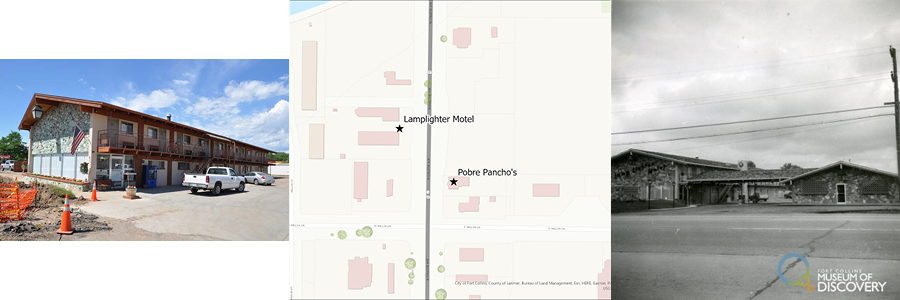
Left: Lamplighter Motel at 1809 N. College Avenue in 2011 (Adam Thomas & Mary Therese Antsey, Historitecture); Right: Lamplighter Motel in 1961, shortly after construction (1809NCol61B, Courtesy of the Fort Collins Museum of Discovery).
The Lamplighter Motel at 1809 N. College was managed by the Aragon family, another long-standing Mexican American family in the community. During the 1970s, the motel had temporary living quarters behind it to the west that sheltered seasonal migrant workers who labored on area farms, mostly of Latinx descent. Cooks were recruited out of Mexico along with the farm laborers to cook for the large number of workers who resided in these kinds of seasonal residences nestled into undeveloped spaces. While no longer present, sites like this demonstrate just how many Latinx immigrants came to the Fort Collins area during the twentieth century, and how important they were to the success of the region’s agricultural foundations. Today, the Lamplighter remains as a local location of the America’s Best Value Inn.
Campus#
Following in the footsteps of Jovita Vallecillo Lobato, many Latinx community members had connections to the Colorado Agricultural College, later renamed Colorado State University, either being local residents seeking more education, or coming to Fort Collins specifically for their college education. In many cases, CSU students and graduates became leaders in the Fort Collins community, running businesses, resisting discrimination, and pressing for social change. CSU Students in particular formed organizations like MACE (Mexican American Committee for Equality) and UMAS (United Mexican American Students, a regional organization with a chapter at CSU) that successfully made change not only on campus but in the community at large.
16 - Morgan Residence, 645 S. Shields Street#
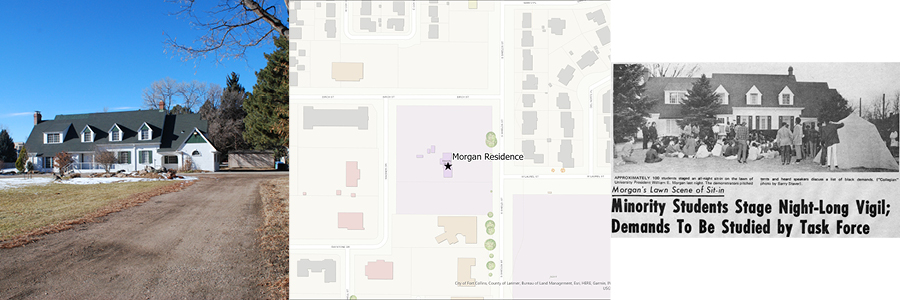
Left: The former President Morgan residence at 645 S. Shields Street, now Colorado State University's Diversity House. Right: The student-led protest by the Black Student Alliance and Mexican American Committee for Equality (MACE) on the front lawn of Morgan's private residence, April 10, 1969. (Courtesy of the Rocky Mountain Collegian).
In April of 1969, following the anniversary of the assassination of Dr. Martin Luther King the year prior, the Black Student Alliance (BSA) and the Mexican-American Committee for Equality (MACE) presented joint demands to address the lack of diversity on campus to the CSU administration, followed by an occupation on April 9 of the Administrative Building and a non-violent protest in front of President William E. Morgan’s residence. Here at the Morgan residence, Black and Chicano/a students held a peaceful, all-night sit-in on the front lawn to draw attention to their cause. Of key concern was a distinct lack of recruitment of people of color as students or employees at the University, but also central to the cause was off-campus housing discrimination by landlords. The result was the formation of a special minority task force to guide a recruitment effort focusing on Black, Chicano, and Indian students, which did not proceed because the Colorado General Assembly and the CSU student body failed to support funding for the effort. This moment, and many other protests between 1969 and 1970, drove attempts at reform regarding issues of race and racism at CSU, some of which met with success.
17 - El Centro & the Lory Student Center#
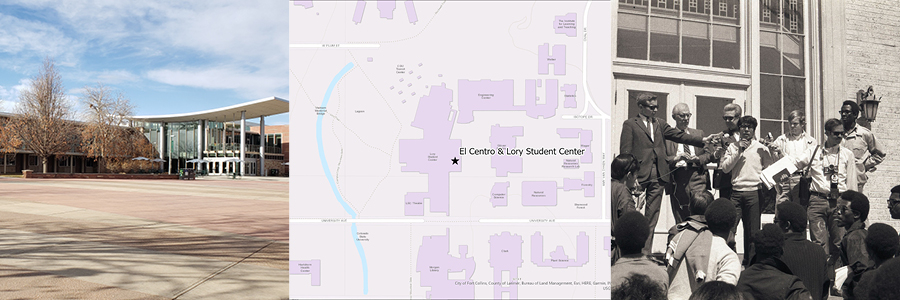
Left: Lory Student Center; Right: Manuel Ramos, one of the founders of the Mexican American Committee for Equality (MACE) at Colorado State University, speaking at a student demonstration co-led by MACE and the Black Student Alliance, 1969 (University Historic Photograph Collection, University Archives & Special Collections, Colorado State University).
CSU’s Lory Student Center (LSC) has been the heart of student activities on campus since it opened in 1962. It has served as the home to student organizations as well as a site of student protests and other major events, such as national civil rights leader James Meredith’s speech in 1963.
The LSC has also been associated with student activism throughout its history, including in 1969 when students presented a list of demands to CSU President William E. Morgan for better equity and to address discrimination on campus. The State and the University failed to make meaningful progress on the recruitment issues, in part because authorities failed to authorize funding for the effort. However, the work of UMAS (United Mexican American Students), MACE (the Mexican American Committee for Equality) and the BSA (Black Student Alliance) ultimately led to the creation of both El Centro (the Latinx student services office), the Black/African American Cultural Center, and an ethnic studies program in the College of Liberal Arts meant to improve education about non-white culture. UMAS and MACE were both responsible for much of the momentum behind El Movimiento in Fort Collins, helping sponsor Chicano heritage awareness events throughout the 1970s, and inviting labor and civil rights advocates from the UFW and other organizations to speak and provide workshops on legal action and organizing.
While respect, inclusion, and diversity continue to be acknowledged in Fort Collins and at CSU, the work of these student protesters provided a path forward that is still recognized and being built today.